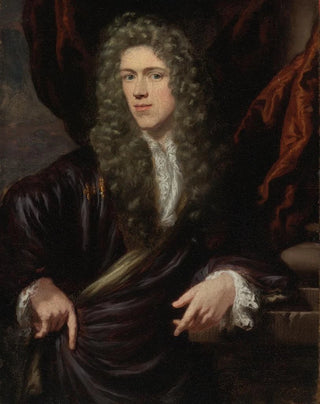Art print | Portrait of a gentleman - Nicolaes Maes


View from behind

Frame (optional)
In the fascinating world of 17th-century painting, the art print "Portrait of a Gentleman" by Nicolaes Maes stands out for its ability to capture the very essence of the depicted individual. This painting, which evokes a time when portraiture was much more than a simple representation, embodies a meeting between art and human psychology. Through the penetrating gaze of the gentleman, one perceives the nuances of his personality, his aspirations, and his social status. The light, texture, and meticulous details combine to offer a visual experience that transcends time, inviting the viewer to immerse themselves in the subject's universe.
Style and uniqueness of the work
Nicolaes Maes's style is characterized by striking realism, mastery of light play, and meticulous attention to detail. In "Portrait of a Gentleman," every element, from the sumptuous drapery of the robe to the delicacy of the facial features, demonstrates exceptional craftsmanship. Shadows and lights blend harmoniously, creating an atmosphere that is both intimate and solemn. The artist manages to infuse a palpable life into his model, giving the impression that he could come to life at any moment. This art print does not merely depict a man; it tells a story, that of an individual in all his complexity, and reflects the values of a society in full transformation. The psychological depth of the piece, combined with impeccable technique, makes it an essential work of the Dutch Golden Age.
The artist and his influence
Nicolaes Maes, born in Dordrecht in 1634, is one of the major representatives of the Dutch painting school. A pupil of Rembrandt, he mastered his master's lessons while developing his own style. His portraits, often imbued with a certain melancholy, testify to a rare artistic sensitivity. Maes does not limit himself to simple representation; he seeks to explore human psychology through his subjects. His influence is felt among many contemporary artists, but also among those of subsequent generations, who saw in him a model of expression and technique. Through his works, Maes contributed to elevating the

Matte finish

View from behind

Frame (optional)
In the fascinating world of 17th-century painting, the art print "Portrait of a Gentleman" by Nicolaes Maes stands out for its ability to capture the very essence of the depicted individual. This painting, which evokes a time when portraiture was much more than a simple representation, embodies a meeting between art and human psychology. Through the penetrating gaze of the gentleman, one perceives the nuances of his personality, his aspirations, and his social status. The light, texture, and meticulous details combine to offer a visual experience that transcends time, inviting the viewer to immerse themselves in the subject's universe.
Style and uniqueness of the work
Nicolaes Maes's style is characterized by striking realism, mastery of light play, and meticulous attention to detail. In "Portrait of a Gentleman," every element, from the sumptuous drapery of the robe to the delicacy of the facial features, demonstrates exceptional craftsmanship. Shadows and lights blend harmoniously, creating an atmosphere that is both intimate and solemn. The artist manages to infuse a palpable life into his model, giving the impression that he could come to life at any moment. This art print does not merely depict a man; it tells a story, that of an individual in all his complexity, and reflects the values of a society in full transformation. The psychological depth of the piece, combined with impeccable technique, makes it an essential work of the Dutch Golden Age.
The artist and his influence
Nicolaes Maes, born in Dordrecht in 1634, is one of the major representatives of the Dutch painting school. A pupil of Rembrandt, he mastered his master's lessons while developing his own style. His portraits, often imbued with a certain melancholy, testify to a rare artistic sensitivity. Maes does not limit himself to simple representation; he seeks to explore human psychology through his subjects. His influence is felt among many contemporary artists, but also among those of subsequent generations, who saw in him a model of expression and technique. Through his works, Maes contributed to elevating the






